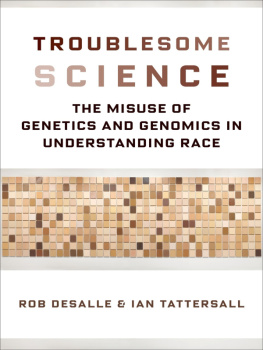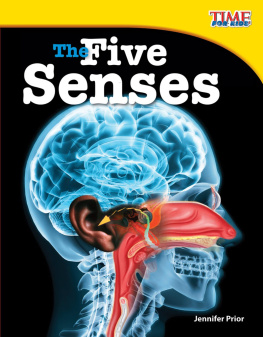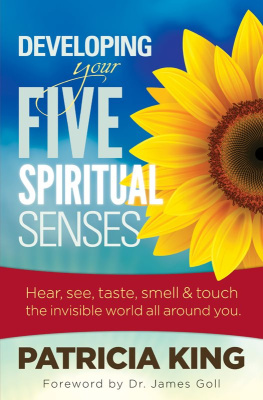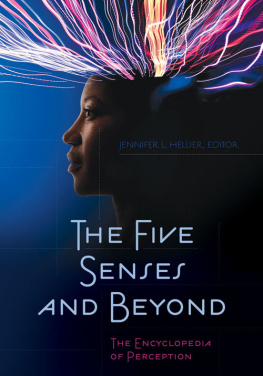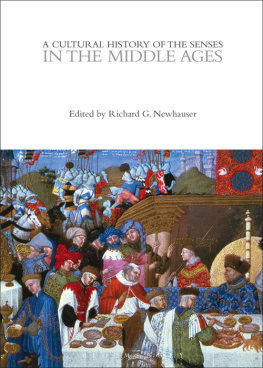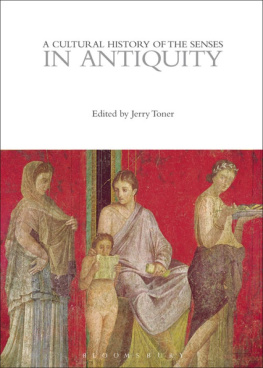OUR SENSES
OUR SENSES
AN IMMERSIVE EXPERIENCE
ROB D E SALLE
ILLUSTRATED BY PATRICIA J. WYNNE

Copyright 2018 by Rob DeSalle. Illustrations by Patricia J. Wynne copyright 2018 by Yale University. All rights reserved.
This book may not be reproduced, in whole or in part, including illustrations, in any form (beyond that copying permitted by Sections 107 and 108 of the US Copyright Law and except by reviewers for the public press), without written permission from the publishers.
Yale University Press books may be purchased in quantity for educational, business, or promotional use. For information, please e-mail (UK office).
Designed by Nancy Ovedovitz. Set in type by Integrated Publishing Solutions, Grand Rapids, Michigan. Printed in the United States of America.
Library of Congress Control Number: 2017944414
ISBN 978-0-300-23019-2 (hardcover : alk. paper)
A catalogue record for this book is available from the British Library.
This paper meets the requirements of ANSI/NISO Z39.48-1992 (Permanence of Paper).
10 9 8 7 6 5 4 3 2 1
CONTENTS
PREFACE
Humans are the only organisms on this planet who can think, read, sing, dance, talk, and, well, do almost anything about thinking. One of the more interesting approaches to understanding this unique aspect of our existence is by examining how our senses work to produce our perception of the world around us. The route from light, sound waves, small odorant molecules, small molecules that induce taste, and other outer world phenomena to what we perceive in our brains makes for a fascinating story about our existence in the natural world. Over the past decade neuroscience has provided novel ways for us to look at our senses and to make sense out of them. From innovative imaging technologies to important genome discoveries to the emergence of incredibly clever cognitive psychology experiments, neurobiology has forged a clearer understanding of what it means to see, hear, smell, touch, maintain balance, and taste not only mechanically but also in how these senses shape our perception of the world aesthetically, artistically, and musically. This book is an exploration of what we know and what new research reveals about our senses. I hope it will excite and stimulate you.
What is a sense and what is not is hard to define. Balance, for instance, is considered a sense but was omitted from Aristotles big five (hearing, smelling, seeing, tasting, and touching). Only recently has it been included as a sense, partly because of the proximity of the balance structures of the inner ear to the auditory system, but mostly because the sense of balance does after all tell our bodies something about our position in the outer world. Some have argued that there are as many as thirty-three discrete senses. But as we will see throughout this book, our perception of the world rarely relies on a single sense, so much so that neuroscientist Laurence Harris has claimed, No sense does anything independently and listing 33 of them may be counterproductive.
Pain, or nociception, is one of the more obvious after balance that needs to be added to the big five. The perception of pain is an interesting topic that for ethical reasons usually centers on whether or not animals feel it. Some even argue that plants feel pain, but we need to discern between response and lack of response to some external stimulus in a neural context, versus a nonneural response when we talk about sensing the outer world. For plants the response is not neural in the same way that our response is. Even if there is a neural response from an organism, we will also need to discern whether the response is indeed one of pain or the pain we perceive. We call it pain, because we experience anguish from the nociceptive receptors responding to heat, cold, or pressure. But it is possible that some organisms with nociception systems dont translate or associate the stimulus with anguish. For instance, although flies will not stick around in extremely hot environments and will respond to heat in very interesting ways, whether they feel anguish as a result is not known. Even fish have been thought to be resilient to connecting nociception with anguish or what we call pain. Some researchers argue that fish do not feel pain because they dont have the neural real estate (they have only a minimal cortex) to produce the perception of pain. Others are adamant that their responses to noxious stimulation are indeed indicative of pain. The moral of this nociception story is that when we discuss the senses and perception, we need to be aware that not all the brains of organisms translate stimulus from the outer world into perception in the same way.
Another sense that is not part of the big five is the simple perception of hot and cold. Flies, as I mentioned, do feel hot and cold, as do most other multicellular eukaryotes and even microbes. This is because the molecular mechanism for temperature reception in flies and humans is similar. Most organisms have a failsafe mechanism for too much heat, called heat-shock response. As part of this response, certain genes produce proteins that are activated when extremes of temperature are encountered. These proteins help the cells cope with the raised temperature. Other genes are present in organisms to help them cope with cold and are referred to as antifreeze proteins. These proteins also assist the cells in dealing with very cold temperatures. Yet, even though in these cases the molecules of cells perceive hot and cold, is this perception the same as takes place in a whole organism? Whether organisms perceive hot or cold depends on whether they have a brain and how that brain processes the information.
For example, certain genes in the fly genome can be mutated so that a fly will not perceive hot or cold. The experiment for detecting these mutants is brutal, in that flies are placed on hot plates and observed. A wild-type fly will skedaddle once the hot plate exceeds ten to twenty degrees above body temperature. Mutant flies, however, will sit until their legs begin to fry. Similar mutants for cold tolerance in flies have also been detected. We can infer that a fly perceives hot and cold, because a response is generated (the skedaddle). Bacteria more than likely do not perceive hot and cold, but their proteins do. So, there is an important line to draw when considering perception and simple physiological response.
Other senses not in the big five might include sensing time of day, magnetic and electric fields, changes in blood pressure, and hunger, among others. But we again need to determine whether we actually perceive these in a neural sense or whether our cells are simply responding physiologically to some external change. Consider blood pressure, for example. When blood pressure rises, we might or might not know it. An extreme rise in blood pressure will trigger certain responses in our bodies that our brains dont outwardly recognize. More than likely the response is physiological and preprogrammed and not perceived. In other words, your body recognizes or senses the change in blood pressure, but you do not always intellectualize it, nor do you often perceive it in the same way that you perceive light hitting the retina of your eyes. So, for the purposes of this book, I will consider these latter candidates as non-Aristotelian senses. I will examine some of them as part of evolutionary systems that arose as responses to environmental change, but when I discuss perception, I will stick mostly with the big five, along with balance, pain, and temperature.
Instead of taking the usual textbook approach of separating the five senses and explaining them in discrete chapters, I will use six important phenomena researchers have recognized that have a role in explaining the senses. First, our senses have arisen as a result of the evolutionary process, and we can learn a lot by placing our neural systems in this evolutionary context. Second, although we can perceive a pretty amazing broad swathe of our outer world quite well, human senses have limitations. But other organisms sometimes have super senses that are an excellent way to describe how they work and what the limits of the range of senses really are for humans. Third, within our species there is a great deal of variabilitythere are people with super senses and diminished senses. Supersensing and diminished-sensing humans not only provide a great way to describe the senses but also illustrate how we use the senses to interpret the outer world around us. Fourth, the senses of some humans have been altered because of trauma. Researchers have learned a lot about these injury-induced anomalies, especially how they relate to brain function. Our senses are also involved in the first steps in interpreting phenomena and situations we encounter. Fifth, our senses interact with one another to produce a coherent perception of the outer world. The extreme of this crossmodality is synesthesia, a situation in humans that mixes the senses so that synesthetes can taste colors and shapes, for instance. A discussion of crossmodality illustrates how our senses and perception work. How we perceive music, art, food, and other external stimuli will also help us understand our senses. This sixth approach to examining our senses illustrates how our senses communicate with one another and how our brains accomplish higher-order functions, such as reading or making music or producing art. In addition, how we place or map ourselves in the context of the outer world using these higher-order functions is an important step to understanding consciousness.
Next page

